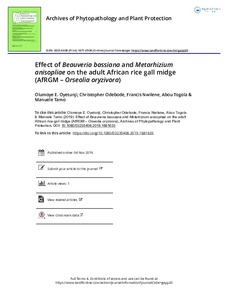| dc.contributor.author | Oyetunji, O.E. |
| dc.contributor.author | Odebode, C. |
| dc.contributor.author | Nwilene, F. |
| dc.contributor.author | Togola, A. |
| dc.contributor.author | Tamo, M. |
| dc.date.accessioned | 2020-08-17T10:37:11Z |
| dc.date.available | 2020-08-17T10:37:11Z |
| dc.date.issued | 2019 |
| dc.identifier.citation | Oyetunji, O.E., Odebode, C., Nwilene, F., Togola, A. & Tamo, M. (2019). Effect of Beauveria bassiana and Metarhizium anisopliae on the adult African rice gall midge (AfRGM–Orseolia oryzivora). Archives of Phytopathology and Plant Protection, 52(9-10), 906-916. |
| dc.identifier.issn | 0323-5408 |
| dc.identifier.uri | https://hdl.handle.net/20.500.12478/6937 |
| dc.description.abstract | Rice is an important staple crop whose production is limited by array of insect pests and diseases. African rice gall midge (AfRGM) Orseolia oryzivora Harris & Gagné (Diptera: Cecidomyiidae) is a major insect pest of lowland rice ecology in Africa. Heavy yield losses have been recorded in many farmers’ rice fields. Use of synthetic insecticides has fostered environmental and human health concern that initiates a search for alternative control measures such as Entomopathogenic fungi (EPF) – Beauveria bassiana and Metarhizium anisopliae. The experiment was laid out on completely randomised design (CRD) with three replications. The study showed M. anisopliae IC30 had the greatest control effect on adult AfRGM with 90.58% of non-infested tillers. The percentage of non-infested tiller advantage over the control followed the same trend with M. anisopliae IC30 having the greatest value of 50.72%. Tiller infestation had significant negative correlation with chlorophyll content, leaf breadth and grain number. |
| dc.format.extent | 906-916 |
| dc.language.iso | en |
| dc.subject | Entomopathogenic Bacteria |
| dc.subject | Fungi |
| dc.subject | Infestation |
| dc.subject | Beauveria Bassiana |
| dc.subject | Metarhizium Anisopliae |
| dc.subject | Rice |
| dc.subject | Pest Insects |
| dc.subject | Insect Diseases |
| dc.title | Effect of Beauveria bassiana and Metarhizium anisopliae on the adult African rice gall midge (AfRGM – Orseolia oryzivora) |
| dc.type | Journal Article |
| cg.contributor.crp | Grain Legumes |
| cg.contributor.affiliation | Africa Rice Center |
| cg.contributor.affiliation | University of Ibadan |
| cg.contributor.affiliation | International Institute of Tropical Agriculture |
| cg.coverage.region | Africa |
| cg.coverage.region | West Africa |
| cg.coverage.country | Nigeria |
| cg.coverage.hub | Headquarters and Western Africa Hub |
| cg.researchtheme | Plant Production and Health |
| cg.identifier.bibtexciteid | OYETUNJI:2019 |
| cg.isijournal | ISI Journal |
| cg.authorship.types | CGIAR and developing country institute |
| cg.iitasubject | Pests of Plants |
| cg.iitasubject | Plant Breeding |
| cg.iitasubject | Plant Diseases |
| cg.iitasubject | Plant Health |
| cg.iitasubject | Plant Production |
| cg.journal | Archives of Phytopathology and Plant Protection |
| cg.notes | Published online: 06 Nov 2019 |
| cg.accessibilitystatus | Limited Access |
| cg.reviewstatus | Peer Review |
| cg.usagerightslicense | Copyrighted; all rights reserved |
| cg.targetaudience | Scientists |
| cg.identifier.doi | https://dx.doi.org/10.1080/03235408.2019.1681633 |
| cg.iitaauthor.identifier | Abou TOGOLA: 0000-0001-6155-8292 |
| cg.iitaauthor.identifier | Manuele Tamò: 0000-0002-5863-7421 |

